2017 Ski-Doo Freeride Review
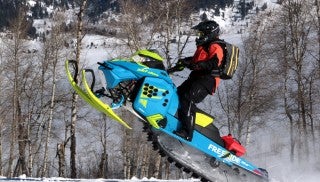
A backcountry tough boy for the extreme rider
It sits somewhat as an orphan this season, the XM RS Freeride from Ski-Doo. Though the Freeride is a premier off-trail deep-powder huck-and-chuck backcountry mountain snowmobile, it is overshadowed by the highly-popular and favored Gen 4 REV Summit X and SP with 850 power.
Engine: 799.5cc Rotax two-cylinder
Power: 150 hp @ 7900 rpm
Track: 16 x 154 x 2.5 PowderMax FlexEdge
MSRP: US$14,099/C$15,799
View Full SpecThe Freeride returns for model year 2017 just as it was in model year 2016, except in a bold sky blue with lime green accents. Truth is, like the RMK Assault, the Freeride is one of our favorite backcountry yee-haw toys, and though it is not an 850 Gen 4 Summit, we still wag our tails in delight. For us, riding a Freeride against the Gen 4’s backdrop is not riding in the shadows at all. But, in all honesty too, after riding the Gen 4 Summit chassis and the XM RS chassis, the XM RS does feel dated; still fun and aggressive in all manners, but outdated when stacked against Gen 4.
Our belief, with no information to write on, is the Freeride will migrate to Gen 4 next season, model year 2018, as we believe the 174 Summit will too as well. (The 174 Summit X remains on the XM chassis for model year 2017.)
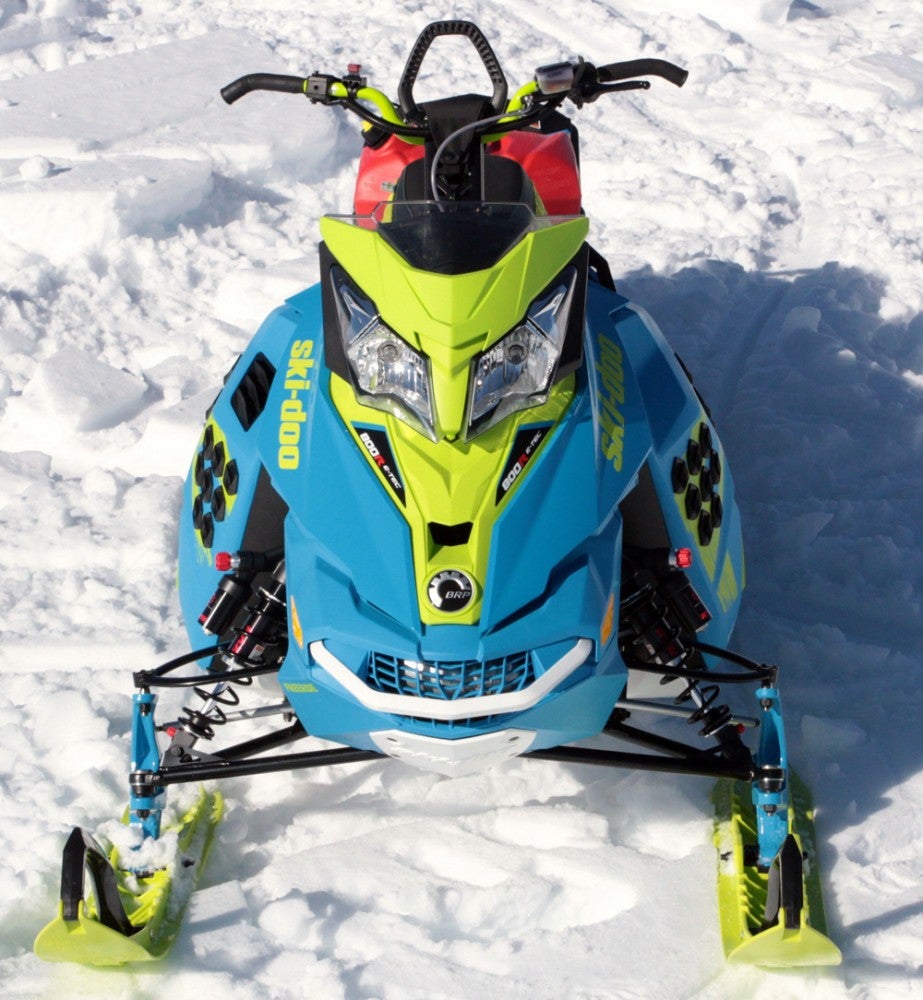
In its blue and lime green colors, accented in white, the XM RS Freeride is meant for the bold driver to be a bold driver.
All that aside, lets pull the hood and side panels off and poke around the XM RS Freeride 146 and 154.
The Freeride has a loyal fan base, riders who wear loud “onesie” suits that need a volume control to quiet down radical colors. And with that, the Freeride is also a color statement-maker coming in Octane Blue with lime green accents (a highly-popular color set for 2017). Yes, it is an in-your-face snowmobile built for the man or woman who is secure in their man- or womanhood. Nah, let’s say they are secure in their skill set.
So, the Freeride is all XM Summit X, but a little bit more. Well, more than a little bit more. Besides its wild blue and lime green color accented with white and black, the Freeride is a reinforced XM Summit X that has a second acronym “RS.” Hence, it is the XM RS Freeride.
The Freeride 154, which is featured here, also has a sister mountain-specific Freeride, the 146. Ski-Doo also offers a 137 Freeride that is more of a deep-powder crossover snowmobile than all-out mountain master; the 137 uses rMotion as its rear suspension. Thus, the 154 and 146 are deep-powder blood hounds that go about their work sniffing out the deepest snow, the tallest drops and the longest rainbow flights over a mountain crest. What we provide here are our impressions of the Freeride 154 with technical information.
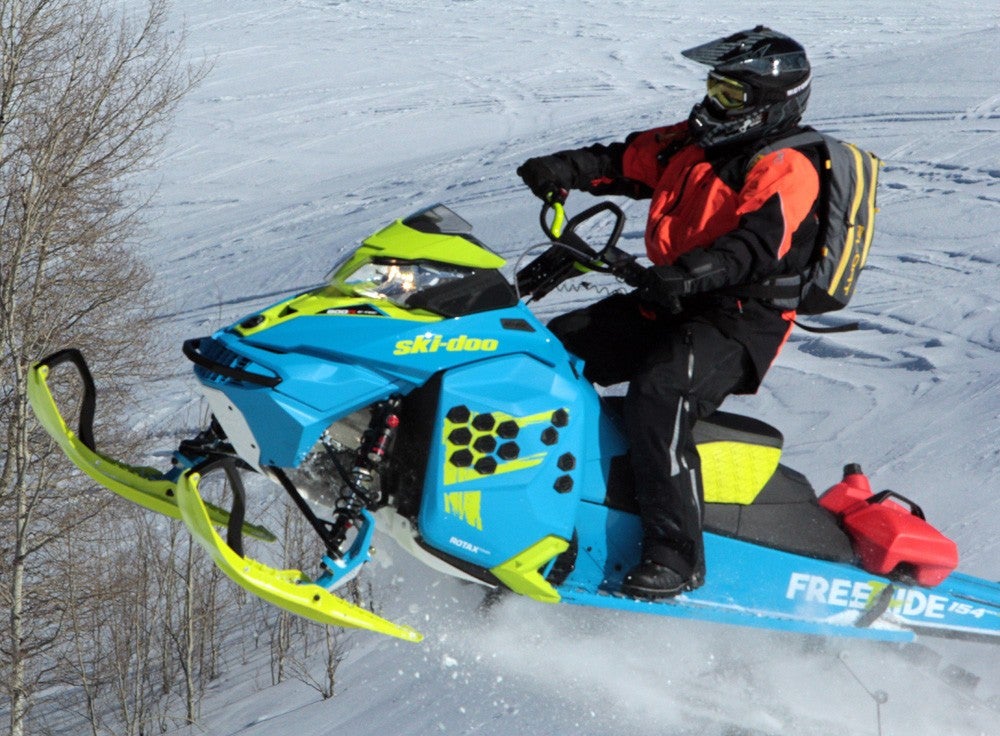
From high atop a mountain, the 154 Freeride is a lively mountain snowmobile where is balanced and predictable for flight.
Supplying power to the Freeride is the reliable electronic direct injection Rotax-built E-TEC 800 R twin cylinder two-stroke This motor is quiet, but don’t let its whisper deceive; the motor is strong. The Freeride’s drive clutch is the TRA VII and the driven clutch is the QRS. Gear ratio for the 154 Freeride is 19/49 (small sprocket/large sprocket).
The 154 Freeride uses the XM-specific tMotion rear suspension with the FlexEdge Powder Max 2 track. The track is 16 inches wide, a proven Ski-Doo tradition, and has a lug height of 2.5 inches. This rear suspension and track technology is also found on the Gen 4 REV Summit X and SP. For the Freeride, the tMotion rear suspension manages bump hits with KYB Pro 40 aluminum Easy Adjust shocks on the rails’ front and rear, 22 dial-adjust clicks are available. Rear suspension travel is 15 inches or 381mm.
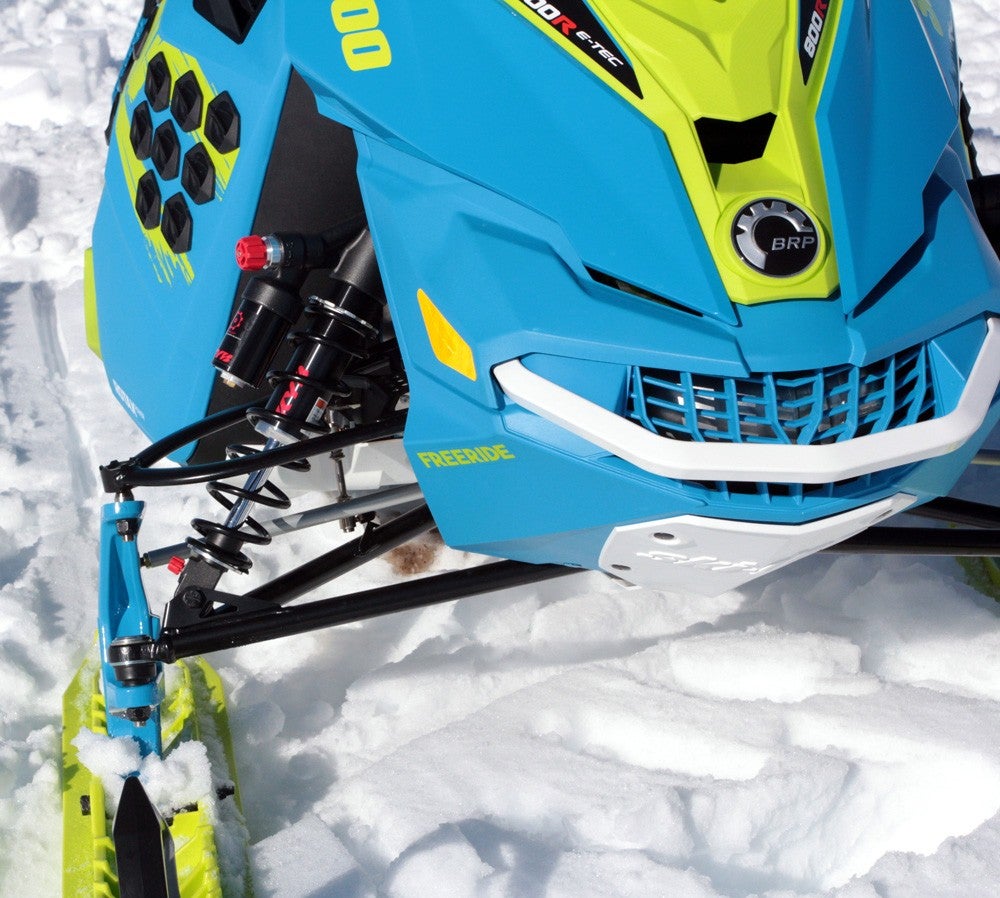
With KYB clicker shocks complete with external reservoirs, the 2017 XM RS Freeride has a front suspension that is meant to absorb big hits from long drops.
The Freeride’s ski stance is an adjustable 38.4 inches to 40.1 inches and has a quick disconnect sway bar to uncouple the front suspension. The front suspension soaks up trail chatter and moguls with KYB 40R Easy Adjust shocks. These Easy Adjust shocks mean just that – dial-in or dial-out resistance (load). With an adjustable ski stance, Easy Adjust shocks and a couple- uncouple-swaybar, the Freeride can be set flat and stiff for uphill carves on a speed course, or narrowed-up, softened and loosened for runs through the trees or on a steep slope. The front suspension’s travel is 8.3 inches or 210mm.
The Freeride tracks on the Summit-designed Pilot DS 2 ski which gives good flotation. There are times though we found the 154 bullied the ski through the powder.
The Freeride is reinforced in key areas where hillclimb competitions and hardcore backcountry freeriders challenge chassis integrity. BRP reinforced the XM RS chassis where the tunnel meets the bulkhead, which does add some weight, but we learned the minimal weight gain did not make the Freeride bulky and difficult to maneuver; it remained nimble as an XM chassis is.
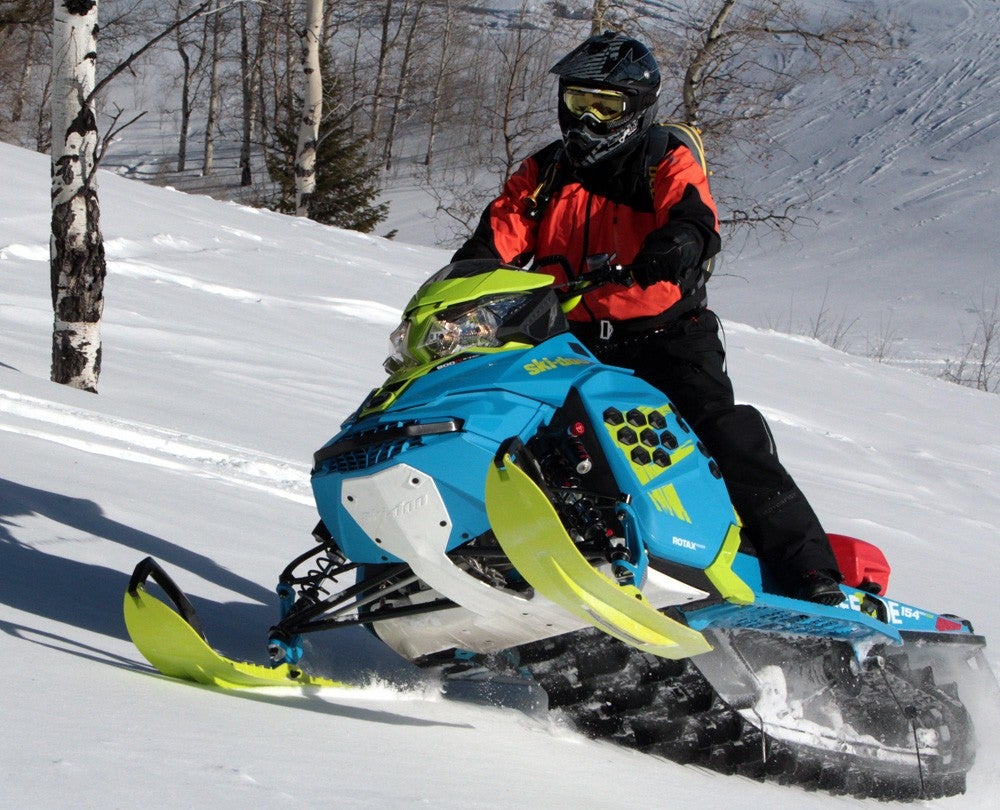
The 2017 Freeride, here the 154, can sidehill with ease. This deep-powder XM RS chassis Freeride is smartly designed for competition and deep-powder riding.
The Freeride 154 competes against Polaris’ AXYS RMK Assault 155 and Arctic Cat’s HCR 8000 153, which both are prepped for backcountry freestyle riding, or hillclimb competition use.
The Freeride has some nice mountain-rider amenities, such as excellent runningboards that are narrow. These foot platforms do not push out the XM RS chassis when cutting a sidehill. The boards evacuate snow, are rigid, and are just wide enough for a snowmobile boot.
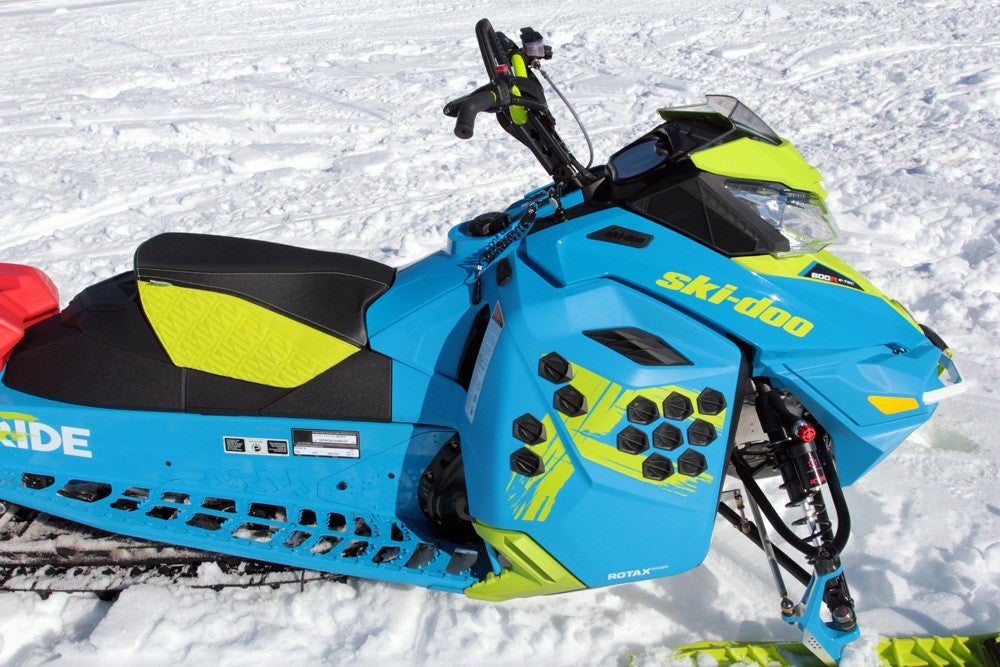
With mountain amenities, such as runningboards with wide holes, mountain handlebars and open toe wells, the Freeride is deep-powder expert.
Other goodies include a seat that is rounded and not overly tall to allow riders to swing their legs around or up and over with ease. The seat has limited storage and could use more. The Freeride, just like the Summit X, has minimalist controls on the handlebars and cockpit for the handlebar and throttle lever heaters, and lights. A goggle warmer behind the instrument pod is a welcome must for powder riders. Curved handlebars with hooks at the ends, and a semi-rigid mountain strap round out some perfect ergos. Also, the painted tunnel reduces snow flash-freeze, thus keeping weight down when in the deep powder.
The Freeride 154 has all the great features we’ve come to know from the previous Summit REV XM platform. The Freeride has engineered-in toughness built into the chassis for the extreme backcountry rider; the reinforcements set this chassis with its own identity, in more ways than one: the REV XM RS platform.
The reinforced chassis, KYB 40 Easy Adjust shocks, adjustable ski stance with swaybar quick-disconnect makes this chassis-package designed for both freestyle abuse and powder fun. For those riders who drop off cornices, perform high flying jumps, fast attack rough trails, or compete in hillclimb competitions, the Freeride 154 is the snowmobile built for you.
If you have a mind set on the Freeride, with its somewhat wide front end will dampen your backcountry riding experience. Not so, by disconnecting the front swaybar, the Freeride becomes a ‘no problem at all’ mountain snowmobile.
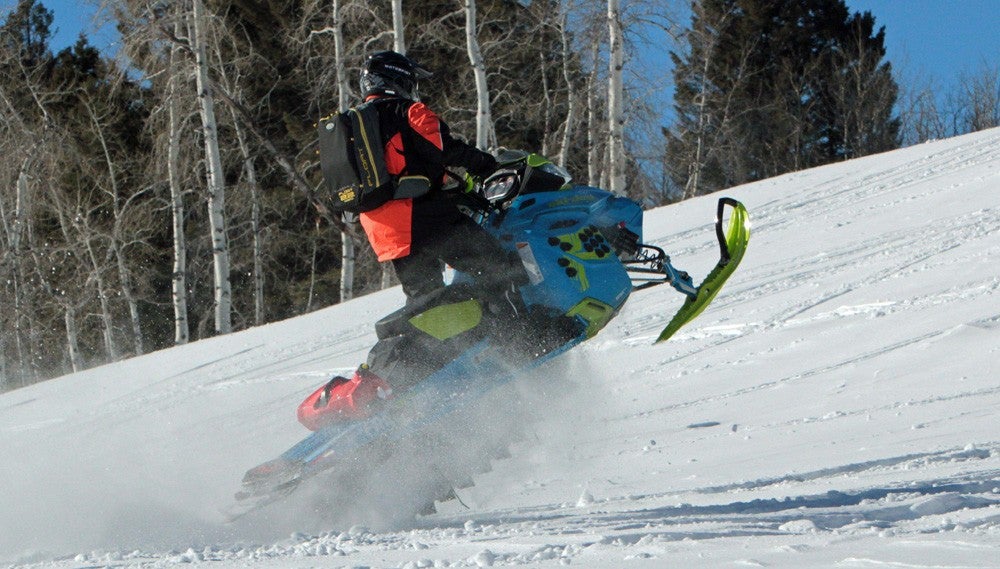
This is a view many will see if chasing a Freeride. With its PowderMax track, 800R power and somewhat light chassis, this mountain sled climbs and runs.
To understand the Freeride is to understand that BRP Ski-Doo is committed to building a snowmobile that fits the mountain backcountry freestyle rider. Furthermore, Ski-Doo wants the freestyle mountain rider to easily pilot a deep powder snowmobile with no concern, though it is designed with a wide front end ski-stance.
To close this down, Ski-Doo invests deeply into market research, building what the snowmobile public demands. Ski-Doo’s vast model lineup proves this. The Freeride 154 is a snowmobile that meets the needs of powder riders, mountain climbers, trail burners and freestyle backcountry stars alike. It is a quadruple threat snowmobile.
But, as mentioned, this model year 2017 Freeride may be shuttled into the room “this is the last year,” as a XM RS with 800 E-Tec power. The 2018 Freeride may be Gen-IV with 850 power; it only makes sense as Ski-Doo continues to run wide-open-throttle with product development. The snowmobile pie is only so big, and Ski-Doo wants to be the biggest shareholder, thus, we assume, the Gen-IV movement will continue on to the Freeride. Yet, this current 2017 blue and green toy is all fun and one that makes us grin, and grin, and grin.




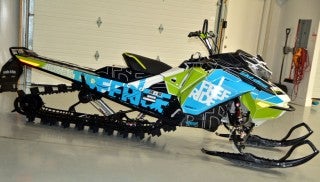
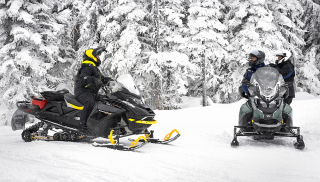


 Your Privacy Choices
Your Privacy Choices